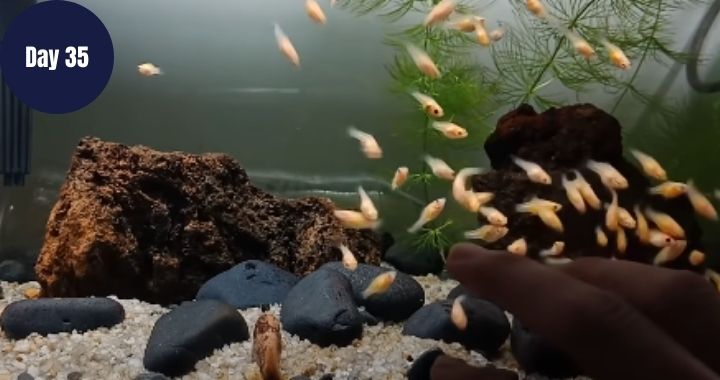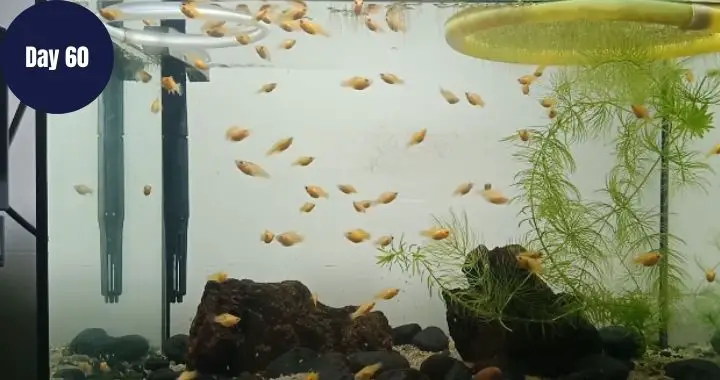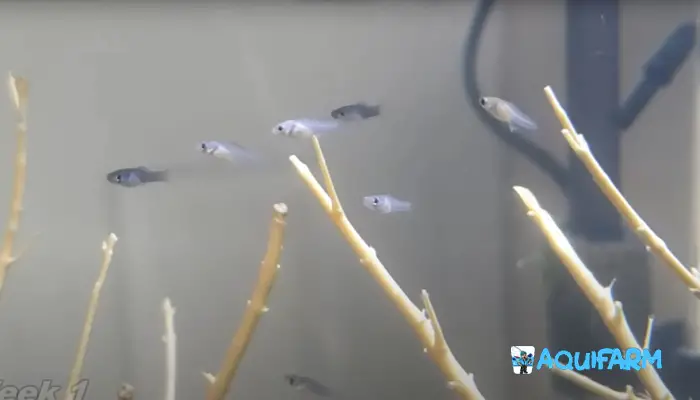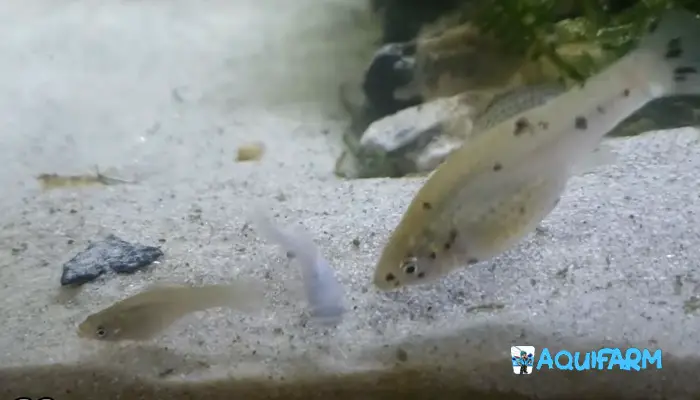
Nowadays molly fish are very popular among aquarium enthusiasts for their vibrant colors and playful nature. Moreover, they are very easy to take care of and they also breed very fast.
However, Molly fish give birth to very small fries and they are very delicate during their initial growth stages and require proper care.
In this article, I am going to discuss their growth stages in detail so that you can easily track your molly fish’s growth and performance by yourself. Besides, you will also be able to compare their growth with the standard chart and figure out if your ones are having any serious problems.
Last but not least, I have included a full care manual for molly fries at the end to help you with many tips to make sure your week old molly fries are growing successfully at a healthy pace.
So, without making any delay let’s get things started–
Important Growth Stages Of Molly Fry
Before diving deep into the article let’s have a quick look at the Molly fish growth chart–
| Stage | Time | Growth status |
| Stage 1 (Fry stage) | First 1 month | Fully transparent |
| Stage 2 (Juvenile stage) | 1-2 month | Reproductive organs starts to develop |
| Stage 3 (Fingerling stage) | 2-4 month | Mollies become sexually mature |
| Stage 4 (Adult stage) | 4-6 month | Show vibrant colors and become adults |
1. Fry Stage (Stage 1)

Basically, Molly fishes do not lay eggs, they give birth to direct small fries about half an inch in size. So this is where the fry’s life starts and this is the most vulnerable stage of their life.
In this stage, it’s very important to separate the mother from the fries because if they are together, the mother will end up eating their offspring. This is why almost half of them don’t survive past this stage.
What I usually do is when the molly is about to give birth, I transfer it to a small separate tank. Just when it gave birth to small fries, I quickly put the mother back in the main tank and let the fries grow separately in the small tank.
In this stage, the fries grow about 2-3 millimeters every week and look transparent fully. The baby mollies stay in this stage for about a month and then enter into the 2nd stage of their life called the juvenile stage.
2. Juvenile Stage (Stage 2)

This stage starts about a month after their birth. Though in this stage they start to develop their reproductive organs or gonopodium by which we can tell the males and females apart. Besides, male mollies are about half an inch smaller than females.
Also, in this stage, they start to develop some color and start to lose their transparency as well. Soon their body becomes dull with tinges of different colors present.
This is the period of rapid growth of the molly fries and they become more independent. Besides, juvenile fries can sense danger and hide from it.
Juveniles are more independent and can now sense and hide from any danger. Rapid growth occurs at the same time.
The size of mollies can be different due to the different breeds. For example, Sailfin mollies or Yucatan mollies have longer fins and look bigger and reach 5-6 inches as an adult. On the other hand, balloon mollies are the smallest ones and grow only 3 inches in size.
3.Fingerling Stage (Stage 3)

This stage is called the fingerling stage because during this time the molly fries reach around the size of a little finger (4-6 inches in length). The fingerling stage starts after two months of their birth after they’ve passed the juvenile period.
Most importantly, in this stage, they become sexually mature. So, if you are not looking to breed them, it’s the right time to separate the male and females into separate tanks. Also, now they are mature enough to be transferred to the main aquarium as there is no risk of them getting eaten by the adult molly fish.
In this stage, they can run from the adult mollies or other predators on their own. However, one can never be too careful with these because the adult molly fish can chase them and bully them to death. So it’s better to place some aquatic plants in the aquarium to provide them a hiding spot.
4. Adult Stage (Stage 4)

After 4 months of their birth, the molly fries become adults and they can live up to 3-5 years. This is the stage where they can live in a tank with other species of fish. However, as they reach adulthood their growth rate starts to decrease and eventually they don’t really grow anymore.
Usually, mollies are vibrantly colorful in this stage but sometimes when they are stressed due to high temperature and ammonia and nitrite poisoning or infected by diseases it can make the colors appear dull.
A healthy female molly fish should start breeding from the fingerling stage and continue to reproduce throughout the adult stage till death. If they are not reproducing then they might be genetically sterile.
Normally the mollies like to be in a group so it’s best to keep at least 3-4 mollies in the aquarium to maintain their social wellbeing.
1 week molly fish fry growth chart
| Day | Size (inches) | Size (mm) | Behavior |
|---|---|---|---|
| 1 | 0.1 – 0.2 | 2 – 5 | Newly hatched, unable to swim |
| 2-3 | 0.2 – 0.3 | 5 – 7 | Becoming more active |
| 4-5 | 0.3 – 0.4 | 7 – 10 | Absorbing yolk sac, seeking food |
| 6-7 | 0.4 – 0.5 | 10 – 12 | Active swimmers, exploring |
Molly Fish Size & Growth Chart (1 week to 8 Weeks)
| Age | Length Range (inches) | Length Range (mm) |
|---|---|---|
| 1 week | 0.4 | 10 |
| 3 weeks | 1 | 25 |
| 1 month | 1–1.5 | 25–38 |
| 3 months | 2–3 | 50–75 |
| 6 months | 3–4 | 75–100 |
| 8 months | 4.5–5 | 115–127 |
How to Take Care Of The Newborn Molly Fry?

Molly fish are very vulnerable when they are in the fry stage and juvenile stage. This is where they need the utmost care otherwise most of them will not survive.
Besides, creating an ideal environment will allow the fries to develop quickly and attain their maximum size.
Follow the tips below to take care of them–
Prepare The Tank
- Use a separate tank having a capacity of minimum 10 gallons and put the mother in there. After breeding take the mother back to the main tank otherwise it will eat the fries.
- If you don’t want to introduce your pregnant molly fish to a new environment, you can also use a breeding box. This has a container inside the main tank that separates the fish fries from the other adult fish. In this case, put the mother molly in the breeding box and after the fries are born take the mother out to the main tank.
Get The Right Environment
- Add plants in the tank to give them enough hiding spots but don’t crowd the tank with too many plants.
- Place the tank in a stable spot and don’t knock on the tank glass because it will make noise and stress the small fries.
- Maintain the 12 hour day- and night cycle by using artificial lights.
- The molly fries won’t grow properly without the right tank parameters. Keep the pH between 7.5 to 8.5 and carbonate hardness 20-25 dKH.
- And use a good aquarium water testing kit to maintain these parameters.
- Since mollies are tropical fish they love a warm environment. So, set the temperature to 70-80 degrees F.
- You can also add a tablespoon of aquarium salt per gallon of water to help the molly fries thrive.
Keep It Clean
- Mollies give birth to hundreds of fries and they generate a lot of waste that sinks into the bottom.
- This waste will rot there if not cleaned regularly.
- This is why changing some water (20-30%) every week is very necessary so the tank can stay free of ammonia, nitrite, and nitrates.
- Use a good water conditioner to get rid of contaminants.
- If the tank walls get dirty, give it a nice scrub because a clean environment will enhance the growth of your molly fish.
Proper Filtration & Aeration
- Avoid any strong filter system because it can generate strong currents and trap the fries inside sucking them in and killing them.
- The most preferred filter for mollies is a sponge filter.
- Add air stones in the tank to ensure enough aeration because mollies need enough supply of oxygen during the fry stage.
Nutritious Food
- Feed them micro worms, infusoria fish food or baby brine shrimps, or baby shrimp eggs. This kind of food will provide a balanced diet for the molly fish fry and reduce the mortality rate.
- Also, you can feed them commercial fish food.
- Avoid feeding them a large amount at once because they are voracious feeders. So, they will eat everything at once and then get sick.
- Instead, feed them 3-4 times a day in small amounts.
- Finally when they reach the “fingerling stage” you can transfer them back to the main tank.
How Long Do The Molly Fish Live?

Depending on various species the Mollies can live up to 5 years. But their long life mostly depends on how we take care of them and provide them with what they need. However, they get sick from time to time and this can be an indicator showing that their life might be in danger.
- Loss of appetite
- They swim sluggishly
- Body areas missing scales
- Rot in the fin and tail area due to bacterial attack
- They hide in a corner and stay there for several days
If you see the following symptoms make sure to check for disease and see if all water parameters are all right and take immediate steps to cure them.
Frequently Asked Questions (FAQs)
How Big Can Molly Fish Grow?
They Are Born Very Small But Depending On The Variety They Can Grow Up To 4-5 Inches In Length. But Most Averagely They Are 3-4 Inches In Size.
Can Mollies Live In Hot Water?
They do love warm water but it has to be near 70-80 degrees F. If the temperature of the water goes above 85 degrees F, they start to get stressed and get sick. Even due to high temperatures, they can lose their body color
Can Mollies Live In A Fish Bowl?
Yes, they can be comfortably living in a fish bowl but the bowl has to be big enough to allow them to swim freely. A 10 gallon bowl aquarium with some aquatic plants will be suitable for the mollies.
Conclusion
Molly fish increases the aesthetic value of our aquarium with their colorful presence. Moreover, they are very easy to take care of too. However, molly fries are very tiny and it can be challenging to raise and take care of them.
In this article, I’ve included their different growth stages in full detail so that you know exactly what steps to take until they are completely grown up. I have also included a full manual on how to take care of them especially when they are immature.
I hope this article has answered all of your questions regarding the molly fish. If you find this helpful, share it with your other aquarist friends. Also, make sure to let us know in our social media what you would like to hear from us in our next article.
- Top 15 Freshwater Aquarium Plant Ideas for a Lush, Green Tank - November 9, 2024
- Top 13 Freshwater Aquarium Layout Ideas for a Beautifully Organized Tank - November 9, 2024
- 14 Stunning Rustic Freshwater Aquarium Ideas for a Tranquil Environment - November 9, 2024
